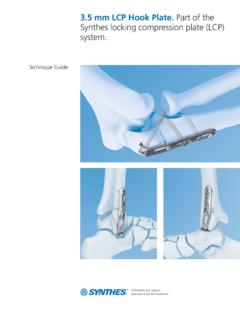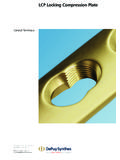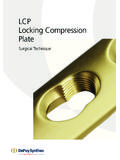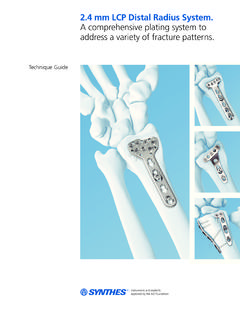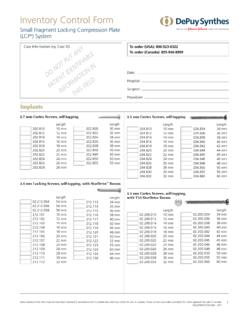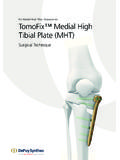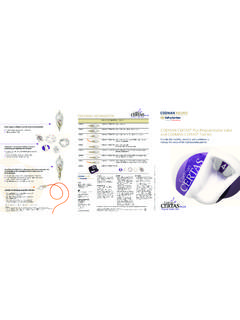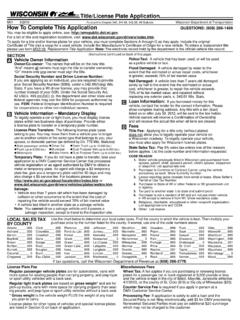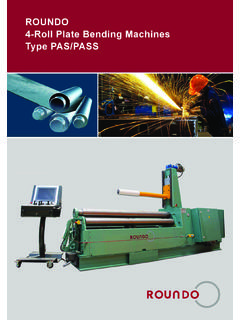Transcription of Less Invasive Stabilization System (LISS). Allows ...
1 less Invasive Stabilization System ( liss ). Allows percutaneous plate insertion and targeting of screws in the distal femur. Technique Guide Table of Contents Introduction less Invasive Stabilization System ( liss ) 2.. Indications 6. Clinical Cases 7. Surgical Technique Preoperative Planning 9. Screw Selection 10. Patient Positioning 12. Incision 13. Reduction 14. Instrument Assembly for Insertion 15. plate Insertion 18. Use of Pull Reduction Instrument 22. Insertion of Locking Screws 25. Postoperative Treatment 32. Troubleshooting 33. Tips 34. Special Techniques 38. Product Information Implants 40. Instruments 41. Set Lists 43. Image intensifier control less Invasive Stabilization System ( liss ) Technique Guide Synthes less Invasive Stabilization System ( liss ). plate osteosynthesis in accordance with AO principles has resulted in improved restoration of full function to the injured limb and mobility to the patient. Infection, refracture, delayed union, and the need for bone graft are not uncommon, although the majority of fractures heal without complication.
2 Develop- ments such as closed, indirect reduction techniques; implants with minimal bone contact; development of internal fixators;. and further advances in the area of extra medullary force carriers have evolved in order to limit soft tissue disruption and preserve the blood supply. The less Invasive Stabilization System ( liss ) is an extramedullary, internal fixation System that has been developed to incorporate these technical innovations and surgical techniques. Its main features are an atraumatic insertion technique, minimal bone contact, and a locked, fixed-angle construct. Biomechanics of unicortical, locked screws Traditional compression plating Traditional bone screws in plates have relied on two forces to create stable fixation: compression between opposing cortices and friction between the plate and bone caused by the screw. A tensile force is generated along the axis of the screw. This tensile force relies on the shear strength of the bone at the screw-thread interface.
3 In particularly hard bone, higher forces can be generated, whereas in softer, osteopenic bone, the shear strength is lower and more susceptible to stripping. As the screw is tightened, its increasing tensile force creates increasing compressive force between the plate and bone. This compression generates a friction force between the bone and plate . Applied load is transferred from the bone to the plate , across the fracture, and back to the bone. A tight frictional interface is key to the load transmission. As long as the applied (patient) load is less than the frictional force, the construct will remain stable. Although a bicortical screw has inherent angular stability, when the patient load exceeds the maximum friction available, some collapse across the fracture gap results. This collapse is due to the lack of angular stability between the plate and the screw. 2 Synthes less Invasive Stabilization System ( liss ) Technique Guide Locked screw- plate constructs Traditional unicortical bone screws have lower load carrying capability than bicortical screws.
4 However, if a unicortical screw is locked to the plate , its load carrying capacity in- creases due to the angular stability. This locked screw- plate connection provides the path for load transmission to the plate . When comparing the load applied to a locked screw with a conventional screw, both screws are subjected to the same patient load. However, load on the bicortical, non- locked screw is always higher due to the initial tightening required to generate friction between the plate and the bone, which ensures stability of the construct. In conventional plating, even though the bone fragments are correctly reduced prior to plate application, if the plate does not fit the bone, the result will be fracture dislocation. If a locked internal fixator is applied to a reduced long bone fracture, the alignment is maintained by the locked screw construct. A locked internal fixator functions as a splint, which relies on relative stability for secondary healing and callus formation.
5 However, this implant does not inherently reduce or align the fracture during its placement (as with a nail). The implant locks the bone segments in their relative positions regardless of how they are reduced. Preshaping the plate minimizes the gap between the plate and the bone, but an exact fit is not necessary for implant stability. A conventional plate must be tightened against the bone in order to generate the frictional forces needed for stability. This compresses the periosteum between the plate and the bone and theoretically compromises blood flow in the area of plate contact. With a locked internal fixator, the plate is not compressed against the bone, thus reducing or avoiding constriction of the local blood supply. liss offers a locking internal fixator construct for use in the distal femur. In addition, the availability of an insertion guide Allows percutaneous targeting of screws through stab incisions.
6 The insertion guide also ensures that all screws will be properly inserted and locked to the plate . less Invasive Stabilization System ( liss ) Technique Guide Synthes 3. less Invasive Stabilization System ( liss ). Traditional plating and locked internal fixators comparison Traditional plating Locked internal fixators Screws tighten plate to bone to generate compression Screws lock to the plate Screw threads in bone are under a load applied Screws inserted into bone with minimal axial preload intraoperatively atient loads (weight and movement) add to the P No stress in the System (bone or plate ) prior to amount of preload on the bone/ plate /screw construct patient loads Features Unicortical locking screws offer angular stability for optimal purchase and reduced stress on the bone. Locking screws perform drilling, tapping and locking Drill Thread to the plate . Tap Locking thread Optimized screw position in the condyles to avoid intercondylar notch and patellofemoral joint and maximize bone purchase.
7 4 Synthes less Invasive Stabilization System ( liss ) Technique Guide Anatomic shape of the plate and locked construct makes intraoperative contouring unnecessary. Percutaneous, submuscular insertion of the plate does not disrupt the cortical blood supply. less Invasive Stabilization System ( liss ) Technique Guide Synthes 5. Indications For fixation of fractions of the distal femur. Distal diaphyseal Distal diaphyseal Intra-articular Intra-articular fracture (AO 33-C3), fracture (AO 33-C3), fracture (AO 33-C3), fracture (AO 33-C3), AP, preoperative lateral, preoperative AP, preoperative lateral, preoperative. Medial and lateral Hoffa fractures are nondisplaced Supracondylar Supracondylar periprosthetic periprosthetic fracture (AO 33-C3) fracture (AO 33-C3). AP, preoperative lateral, preoperative 6 Synthes less Invasive Stabilization System ( liss ) Technique Guide Clinical Cases Complex articular fracture Case 1. Female, 47 years old, AO classification 33-C3 with pulmonary contusion and contralateral traumatic knee arthrotomy.
8 Preoperative frontal plane CT of distal femur Preoperative AP Preoperative oblique demonstrates intercondylar notch fragment demonstrates multiplane articular involvement Three-month Three-month post- post-operative AP operative lateral shows callus formation. Patient begins weight bearing at this time less Invasive Stabilization System ( liss ) Technique Guide Synthes 7. Clinical Cases Periprosthetic fracture Case 2. Female, 62 years old, AO classification 33-A2 above a total knee arthroplasty. Preoperative traction Preoperative traction AP lateral; no signs of femoral component Three-month Three-month loosening post-operative AP postoperative lateral with significant fracture consolidation. Patient begins weight bearing at this time. 8 Synthes less Invasive Stabilization System ( liss ) Technique Guide Preoperative Planning Use the AO preoperative planning template to determine the length of the plate and position of the screws.
9 In general, liss plate length and screw positions are selected similarly to external fixator determinations. At least four (4) screws should be placed in the intact shaft proximal to the fracture. The selected liss plate should be longer than a traditional plate . Screw hole inserts Instruments Distal Femur liss Insertion Guide, left or Distal Femur liss Insertion Guide, right Stopper, for liss Insertion Guides Insertion Sleeve The preoperative planning template is also used to determine which plate holes will be located at the fracture site. To pre- vent tissue in-growth and facilitate implant removal, mm screw hole inserts may be used to fill plate holes that will not be used. Screw hole inserts should be placed prior to plate insertion and the corresponding distal femur liss insertion guide holes marked with stoppers. If a screw must replace a screw hole insert intraoperatively, the insert can easily be removed through an insertion sleeve.
10 less Invasive Stabilization System ( liss ) Technique Guide Synthes 9. Screw Selection The plate shape, and screw angles and lengths were developed from computerized tomography (CT) of cadaver E. bones. As a result, a reference measurement guide for distal D F. screws, below, was developed. Screw lengths may also be determined by measurement over a Kirschner wire (see A. Measuring for distal screw length on page 29) or direct C G. measurement from an x-ray. B. Determining distal screw lengths (alpha holes A G). Instruments mm Kirschner Wire, 280 mm 1. mm Kirschner Wire Measuring Device mm Kirschner Wire Insertion Sleeve 2. Measure the maximum condyle width in AP projection. This can be measured directly from an x-ray or using a mm Kirschner wire through the mm Kirschner wire 3. insertion sleeve and the mm Kirschner wire measuring device. If injured femoral condyles are not intact, a measure- ment can be obtained from the contralateral femur.
